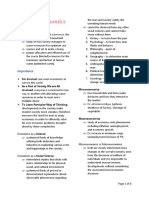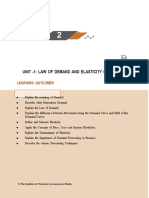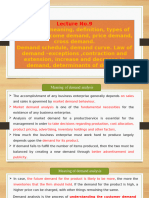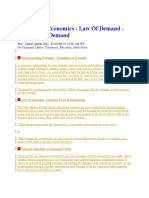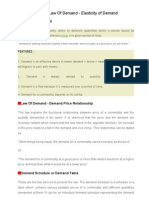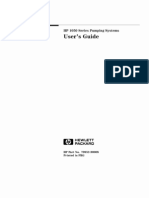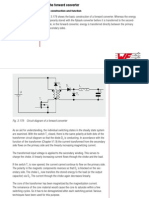Module 2
Module 2
Uploaded by
A Kaur MarwahCopyright:
Available Formats
Module 2
Module 2
Uploaded by
A Kaur MarwahOriginal Description:
Original Title
Copyright
Available Formats
Share this document
Did you find this document useful?
Is this content inappropriate?
Copyright:
Available Formats
Module 2
Module 2
Uploaded by
A Kaur MarwahCopyright:
Available Formats
Managerial Economics 13
Unit 2: Consumer Behavior
Structure
Notes
2.1. Objectives
2.2. Introduction
2.3. Demand Function
2.4. Determinants of demand
2.5. Law of Demand
2.6. Exceptions to the Law of Demand
2.7. Shift of Demand v/s Expansion or Contraction of Demand
2.8. Demand Elasticity
2.9. Types of Elasticity
2.10. Methods of measuring elasticity and its significance
2.11. Demand Forecasting
2.12. Supply Function
2.13. Factors affecting Supply
2.14. Elasticity of Supply
2.15. Budget Constraint
2.16. Indifference Curves Analysis
2.17. Consumer Equilibrium and Consumer Surplus
2.18. Summary
2.19. Check Your Progress
2.20. Questions and Exercises
2.21. Further Readings
2.1. Objectives
The objective of this chapter is to define and analysis of consumer behavior. The
chapter also focuses on the Demand Function, Determinant of Demand, Law of Demand
and Exceptions, Elasticities of Demand and their Measurements, Demand Forecasting
Methods, Supply Function, Elasticities of Supply, Indifference Curve Analysis, Consumer
Equilibrium and Consumer Surplus. Graphs are used consistently in this chapter for
understanding the subject matter easily.
Key Terms:
Demand, Demand Function, Determinant of Demand, Law of Demand, Elasticity,
Demand Forecasting Methods, Supply, Supply Function, Indifference Curve, Consumer
Equilibrium and Consumer Surplus.
2.2. Introduction
The amount of good that a consumer is willing to buy and able to purchase over a
period of time, at a certain price is known as the quantity demanded of that good. The
quantity desired to be purchased may be different from the quantity of good actually
bought by the consumer. Quantity demanded is a flow concept, so the relevant time
dimension has to be mentioned which will indicate the quantity demanded per unit of
time.
Amity Directorate of Distance & Online Education
14 Managerial Economics
2.3. Demand Function
Notes Demand is a relationship between the price and the quantity demanded, other things
remaining the same. If X1 denotes the quantity demanded and P1 its price per unit of the
good, then other things remaining constant, the demand function is;
X1 = f (P1),
Which shows that quantity demanded depends on the price. This means that any
change in price will result in a corresponding change in the quantity demanded.
2.4. Determinants of demand
The determinants of demand for a product and the nature of relationship between
demand and its determinants are very important factors for analyzing and estimating
demand for the product. The most important determinants are as follows:
1. Price of the product.
2. Price of the related goods Complements and Supplements.
3. Level of consumers’ income.
4. Customers’ taste and preference.
5. Advertisement of the product.
6. Consumers’ expectations about future price and Supply position.
7. Demonstration effect and ‘Band-Wagon’ effect.
8. Consumer-credit facility.
9. Population of the country (Goods for mass consumption).
10. Distribution pattern of the National Income.
2.5. Law of Demand
The law of demand states that other things being constant, price and quantity
demanded have an inverse relationship; i.e. as price of a product increases quantity
demanded decreases and vice versa. This law states that there is an inverse relationship
between price and quantity demanded, as price increases, quantity demanded will
decrease. The law of demand can be explained in terms of substitution and income
effects resulting from price changes. The substitution effect reflects changing opportunity
costs. When price of good increases, its opportunity cost in terms of other goods is also
increases. Consequently, consumers may substitute other goods for the good that has
become more expensive.
2.6. Exceptions to the Law of Demand
Though normally law of demand applies to all situations, but there are few cases
where the law does not hold goods, therefore these are regarded as exceptions to the
law. These are the goods which are demanded less at low price and more at high price.
Let us discuss some such exceptions here.
Giffen goods: the case of Giffen Goods needs a little bit of story telling! In early
Ireland it was observed that the poor population consumed two goods: meat (which was
costly) and bread (which was cheap). A very strange phenomenon was observed when
the price of the bread was increased, it made a large drain on the resources of the poor
people and raised their marginal utility of money to such an extent that they were forced
to curtail there consumption of meat and buy more of bread, which was still the cheapest
food. This implied that quantity demand of bread (an inferior good) increased with the
increase in its price. Sir Robert Giffin, an economist, was the first to give an explanation
to this situation. Hence such goods which display direct price demand relationship are
Amity Directorate of Distance & Online Education
Managerial Economics 15
called Giffin Goods. These goods are considered inferior by the consumer, but they
occupy a significant place in the individual’s consumption basket. It so happens that
people in this case, with the rise of price of this good (say rice), are forced to reduce their
Notes
purchase of other expensive goods (say, chicken) and increase the purchase of that good
(rice) in larger quantity to supplement the reduction in luxury food item (chicken). These
goods categorically are those on which major portion of consumer’s income is spent,
hence they are termed as inferior.
Snob Appeal: opposite to Giffen Goods, there are certain goods which have snob
value, for which the consumer measures the satisfaction derived from there commodities
not by their utility value, but by their social status. The consumer of this particular
commodity wants to show it off to others, and as a result they buy less of it at lower
prices and more at higher prices. Thus in this case, price and quantity move in the same
direction. Diamond or antique works of art, latest model of mobile phones, sports cars,
and designer clothes are example of such goods. Higher is the price of diamond, higher is
the snob value attached to it and higher is its demand. These goods are sometimes also
known as Vevlen Goods after the economist Thorstein Vevlen.
2.7. Shift of Demand v/s Expansion or Contraction of Demand
Demand curve shows the relationship between price of a commodity and demand
at that price, ceteris paribus. If the price changes, the demand will also change along
the same demand curve. Thus movement along the same demand curve is known as a
contraction or expansion in quantity demanded, which occurs due to rise or fall in price
of the commodity.
When price of a good remain the same but any one of the other determinants changed
then we will get a new demand curve. So, when demand increases without any change in
price of that good, the demand curve will shift to the right and with a reduction in demand,
the demand curve will shift to the left.
Amity Directorate of Distance & Online Education
16 Managerial Economics
Notes
2.8 Demand Elasticity
Law of demand gives us the direction of change in demand if the price of the product
changes. But this information is not of much practical use since we know only the direction
of change in the demand for a given change in the price. For decision making, we need
the magnitude of this demand and elasticity of demand can gives this changes. The
elasticity of demand helps to understand the extent to which the quantity demanded will
rise (fall) due to fall (rise) in the price of the same good or a related good or due to rise
(fall) in the income of the consumer. This involves an analysis of demand sensitivity with
respect to prices of goods and income which helps the business to forecast market trends
for the future.
2.9 Types of Elasticity
There are many types of elasticity but the main and important types are as follows:
i) Price elasticity of demand
ii) Income Elasticity of Demand
iii) The Cross-price Elasticity of demand
iv) Advertising Elasticity of Demand
2.10 Methods of measuring elasticity and its significance
There are many types of elasticity of demand like determinants. But here we will
discuss the most important three elasticity a) Price Elasticity of Demand, b) Income
Elasticity of Demand, c) Cross-price Elasticity of Demand d) Advertising Elasticity of
Demand.
Price elasticity of demand (ep)
ep = percentage change in quantity demanded resulting from one percent change in
the price of the good, other things remaining constant.
percentage change in quantity demanded
ep =
percentage change in price
Amity Directorate of Distance & Online Education
Managerial Economics 17
Percentage change in quantity demanded = [change in quantity demanded / original
quantity demanded] * 100
Notes
Percentage change in price = [change in price / original price] *100
Combining the above two, we have,
change in quantity demanded/original quantity demanded
ep =
change in price/original price
= [∂Q / ∂P] * [P / Q],
Where,
∂Q = Infinitesimal change in quantity,
∂P = Infinitesimal change in price,
P = original price and Q = original quantity demanded of the good.
Some important concepts
Perfectly elastic demand: A very small amount of change in the price will result in a
change in the quantity demanded to the extent of infinity. Ep = ∞
Perfectly inelastic demand: A change in price, however large it may be, causes no
change in quantity demanded. Ep = 0.
Unit elasticity of demand: When a given change in the price causes an equally
proportionate change in the quantity demanded the value of price elasticity of demand
id unitary. Ep = 1.
Relatively elastic demand: Here a change in the price results in more than
proportionate change in the quantity demanded. Ep > 1.
Relatively inelastic demand: Here a change in the price results in less than
proportionate change in the quantity demanded. Ep < 1.
Unitary Elastic % ΔQ = % ΔP Ep = 1.
Elastic ΔQ > % ΔP Ep > 1.
Perfectly Elastic % ΔP = 0 Ep = “.
Relatively Elastic % ΔQ < % ΔP Ep < 1.
Perfectly Inelastic % ΔQ = 0 Ep = 0.
Income Elasticity of Demand
It is defined as the proportionate change in the quantity demanded resulting from a
proportionate change in income.
Ey = [∂Q / Q] / [∂Y / Y] = [∂Q / ∂Y] * [Y / Q]
It is clear that the sign of the elasticity depends on the sign of the derivative δQ / δY
as both of the expressions Q and Y are positive, i.e., Q>0 & Y>0. The income elasticity
is positive for normal goods. A commodity is considered to be a ‘luxury’ if its income
elasticity is greater than unity. A commodity is considered to be a ‘necessity’ if its income
elasticity is less than unity.
The main determinants of income elasticity are:
1. The nature of the need that the commodity covers: the percentage of income
spent on food declines as income increases.
Amity Directorate of Distance & Online Education
18 Managerial Economics
2. The initial level of income of a country: for example, a TV set is a ‘luxury’ in an
underdeveloped and poor country, while it is a ‘necessity’ in a country with high
Notes per-capita income.
3. The time period: consumption patterns adjust with a time lag to changes in
income.
The Cross-price Elasticity of demand
The cross-price elasticity of demand is defined as the proportionate change in the
quantity demanded of product i resulting from a proportionate change in the price of the
product j. Symbolically the cross-price elasticity is:
Ecij = [Percentage change in the quantity demanded of the ith good / Percentage
change in the price of the jth good]
= [(∂Qi / Qi)*100] / [(∂Pj / Pj)*100]
= [∂Qi / ∂Pj] * [Pj / Qi],
As price and quantity values cannot be negative terms, the sign of the cross price
elasticity is determined by the sign of the derivative ∂Qi / ∂Pj.
The sign of cross price elasticity is negative if i and j are complementary goods, and
is positive if i and j are substitute goods. The higher the value of the cross-price elasticity
the stronger will be the degree of substitutability or complementarities of i and j. The main
determinant of the cross elasticity is the nature of the commodities relative to their uses.
If two commodities can satisfy equally well the same need, the cross elasticity is high and
vice versa.
Advertising Elasticity of Demand
It is defined as the rate of change in the quantity demanded of a good due to change
in the advertisement expenditure of the product.
Ey = [∂Q/Q] / [∂ADexp/ADexp] = [∂Q/δADexp] * [ADexp/Q]
It measures the response of quantity demanded to change in the expenditure on
advertisement. It has been seen that some goods are more responsive to advertising,
i.e., cosmetics.
2.11. Demand Forecasting
There are so many methods for forecasting demand. Here we will discuss the main
methods. Broadly they are divided into two groups:
1. Survey Methods.
2. Statistical Methods.
1. Survey Methods.
Survey methods are generally used where the purpose is to make short-run forecast
of demand. Under the survey methods there are two types of survey: I) Consumer Survey
Methods – Direct Interviews, and ii) Opinion Poll Methods.
i) Consumer Survey Methods – Direct Interviews
The customer survey method of demand forecasting involves of the potential
consumers. It may be in the form of:
a) Complete enumeration,
b) Sample survey,
c) End-use method.
Amity Directorate of Distance & Online Education
Managerial Economics 19
a) Complete enumeration method
By this method, almost all potential users of the product are contacted and are asked Notes
about their plan of purchasing the product in question. The quantities indicated by the
consumers are added together to obtain the probable demand for the product. The
main limitation of this method is that it can be used successfully only in case of those
products whose consumers are concentrated in a certain region or locality.
b) Sample survey
In this method, only a few potential consumers and users selected from the relevant
market through a sampling method are surveyed. Method of survey may be direct
interview or mailed questionnaire to the sample-consumers. This method is generally
used to estimate short-term demand from business firm, government department and
agencies and also by the households who plan their future purchases.
c) End-use method
This method of demand forecasting has a considerable theoretical and practical
value, especially in forecasting demand for inputs. This method requires building up
a schedule of probable aggregate future demand for inputs by consuming industries
and various other sectors. This method has two exclusive advantages. First, it is
possible to work out the future demand for an industrial product in considerable details
by types and size. Second, in forecasting demand by this method, it is possible to
trace and pinpoint at any time in future as to where and why the actual consumption
has deviated from the estimated demand.
ii) Opinion Poll Methods
The opinion poll methods aim at collecting opinions of those who are suppose to
possess knowledge of the market, i.e., sales representatives, professional marketing
experts and consultants. This method includes;
a) Expert-opinion method.
b) Delphi Method.
c) Market studies and experiments.
a) Expert-opinion method
The estimates of demand can obtain from different regions are added up to get the
overall probable demand for a product. The firms are not having this facility; gather
similar information about the demand for their products through the professional
markets experts or consultants, who can, through their experience and expertise,
predict the future demand. This is called opinion poll method.
b) Delphi Method
This method of demand forecasting is an extension of the simple expert opinion poll
method. Under this method, the experts are provided information on estimates of
forecasts of their experts along with the underlying assumptions. The experts may
revise their own estimates in the light of forecasts constitutes the final forecast.
c) Market studies and experiments
It is an alternative method of collecting necessary information regarding demand is
to carry out market studies and experiments on consumer’s behavior under actual,
though controlled, market conditions. This method is known in common parlance as
market experiment method.
2. Statistical Methods
This method is utilizes historical (time-series) and data for estimating long-term
demand. This method is considered superior techniques of demand forecasting for the
following reasons:
Amity Directorate of Distance & Online Education
20 Managerial Economics
In this method, the elements of subjectivity are minimum.
Notes Method of estimation is scientific.
Estimates are relatively more reliable.
It involves smaller cost.
Statistical methods of demand projection include the following techniques;
1. Trend Projection Methods.
2. Barometric Methods.
3. Econometric Method.
2.12. Supply Function
Supply of a good refers to the various quantities of the good which a seller is willing
and able to sell at different prices in a given market, at a particular point of time, other
things remaining the same. Supply is related to scarcity. It is only the scarce goods which
have a supply price. On the other hand, goods which are available freely have no supply
price, i.e., air is available freely and hence does not have supply price. The law of supply
states that other things remaining the same, more of a good are supplied at a higher price
and less of it is supplied at a lower price.
The law of supply takes into account only the most important determinant of supply,
viz., the price of the good. So, the supply function is;
Sx = f(Px), other things remaining the same,
where,
Sx = Amount of good X supplied,
Px = Price of good X.
2.13. Factors affecting Supply
The followings are the major factors affecting the supply of the good:
i) Price of the Good.
ii) Prices of other goods.
iii) Prices of factors of Production.
iv) State of Technology.
2.14. Elasticity of Supply
Price Elasticity of Supply refers to the percentage change in quantity supplied due to
one percentage change in the price of that good.
Es = [Percentage change in quantity supplied / Percentage change in the price]
= [∂Qs/Qs] / [∂P/P] = [∂Qs/”P] * [P/Qs]
Where,
Qs = Original quantity supplied, P = Original price,
∂Qs = Change in quantity supplied,
∂P = Change in price.
Amity Directorate of Distance & Online Education
Managerial Economics 21
2.15. Budget Constraint
The consumer has a given income which sets limits to his maximizing behaviour. Notes
Income acts as a constraint in the attempt for maximizing utility. The income constraint,
in the case of two commodities, may be as:
Y = PX QX + PY QY
The income constraint graphically present by the budget line, whose equation is
derived as,
1 PX
QY- Y- QX-
PY PY
Assigning successive values of QX, we may find the corresponding values of QY. Thus,
if QX = 0, the consumer can buy Y/ PY units of good y. Similarly, if QY = 0, the consumer
can buy Y/ PX units of good x.
2.16. Indifference Curves Analysis
The consumer behaviour analysis was expanded to new horizons with the introduction
of indifference curve analysis by J.R. Hicks and R.G.D. Allen. In this analysis, the utility is
ordinally measurable. If we plot the quantities of two commodities on the two axes, then
we get a set of points that would present alternative combination of the two commodities,
between which the consumer would be indifferent. The curve joining such points is known
as an indifference curve. So, indifference curve is the locus of points which show the
different combinations of two commodities a consumer is indifferent about the points A
or B or C or D.
Amity Directorate of Distance & Online Education
22 Managerial Economics
Notes
2.17. Consumer Equilibrium and Consumer Surplus
The consumer is in equilibrium when he maximizes his utility, given his income and
market prices. Two conditions must be fulfilled for the consumer to be in equilibrium. The
first condition is that the marginal rate of substitution be equal to the ratio of commodity
prices
MUx Px
MRSx,y- =
MUy Py
This is a necessary but not sufficient condition for equilibrium. The second condition is
that the indifference curves be convex to the origin. This condition is fulfilled by the axiom
of diminishing MRSx,y, which states that the slope of the indifference curve decreases as
we move along the curve from left to right.
Amity Directorate of Distance & Online Education
Managerial Economics 23
At the point of tangency the slopes of the budget line and of the indifference curve are
equal:
Notes
MUx Px
=
MUy Py
Thus the first-order condition is denoted graphically by the point of tangency of the
two relevant curves. The second-order condition is implied by the convex shape of the
indifference curve. The consumer maximizes his utility by buying Xe and Ye amount of
the two commodities.
The concept of consumer surplus was first introduced by Marshal. Consumer surplus
is the difference between the price consumers are willing to pay and what they actually
pay. The amount that the consumer is willing to pay for the first unit of good he buys
is termed as consumers’ marginal value. The marginal value decreases as more and
more units are bought. A consumer who maximizes marginal value will buy to that extent
where marginal value equals price. A graphically presentation of consumer surplus is
given below.
AB is the demand curve of a consumer. The consumer is willing to pay a price of
q1p1 for q1 units of goods. For q2 units of goods he will be willing to pay q2p2. And for Q,
he will be willing to pay QN and so on. Now, suppose that the market price is OP, which
the consumer can decide about the quantity of good he would like to demand. With the
demand curve AB, he will demand OQ. Here, the consumer actually pays OP per unit
of the good, but he was willing to pay more than OP for any unit to the left of Q. For
the quantity q1, the consumer is willing to pay q1 p1, but he actually pays q1r1. Hence, the
consumer surplus is (q 1p 1 - q 1r 1) = r1p1. In the same way for q2, the consumer surplus is
r2p2 and for Q, it is zero. If the quantities are finally divisible, the total amount that the
consumer is willing to pay is the area OANQ, whereas what he actually pays is the area
OPNQ and the consumer’s surplus is the area APN.
2.18. Summary
Demand refers to the number of units of a good or service that consumers are willing
and able to buy at each price during a specified interval of time. Changes in demand can
be caused by changes in tastes and preferences, income and prices of other goods and
services also. Marginal revenue is the change in total revenue per unit change in demand.
Total revenue is increasing when marginal revenue is positive. Marginal revenue is zero at
the maximum point of total revenue and total revenue is declining when marginal revenue
is negative. Elasticity measures the responsiveness of demand to various factors. Price
elasticity of demand is defined as the percentage change in quantity demanded per 1
percent change in price.
Amity Directorate of Distance & Online Education
24 Managerial Economics
Check Your Progress
Notes 1. Which of the following statements is true?
(a) When the supply increases, both the price and the quantity will increase,
(b) When the supply increases, the supply curve shifts towards the left,
(c) A shift in the supply curve towards the right results in a fall in the price,
(d) A decrease in the quantity supplied results in shifting of the supply curve towards
the left.
2. Which of the following statements is false?
(a) An increase in tax will affect the customers more than the producers if the supply
schedule is inelastic,
(b) An increase in tax will affect the customers more than the producers if the demand
schedule is inelastic,
(c) Both (a) and (d) above,
(d) An increase in tax will affect the customers less than the producers if the demand
schedule is inelastic.
3. For complementary goods, the cross elasticity of demand will be
(a) Zero, (b) Infinity,
(c) Positive but less than one, (d) Negative.
4. When the income elasticity of demand for a good is negative, the good is
(a) Normal good, (b) Luxury good,
(c) Inferior good, (d) Giffen good.
5. If both income and substitution-effects are strong, this region of the demand curve
must be
(a) Relatively price elastic, (b) Relatively price inelastic,
(c) Unit-elastic, (d) Perfectly inelastic.
Questions and Exercises
1. Explain the utility analysis for understanding consumer behaviour and demand.
2. What is the Law of Diminishing Marginal Utility? Explain law with empirical example.
3. State and explain the properties of Indifference Curve.
4. Explain the Law of Diminishing Marginal Rate of Substitutions.
5. State the law of demand with some exceptions.
6. “The law of demand is always applicable to marginal buyers and is usually applicable
to intra-marginal buyers.” Comment.
7. Distinguished between substitutes and complements with examples. How does this
distinction of goods help in business decision making?
8. If price of milk increases, what do you think will happen to the demand for
cornflakes?
9. What are the factors that cause the demand curve to shift?
10. If the demand is fixed but supply of a product increases, what happens to equilibrium
price and quantity?
11. If the market demand curve is given by Qd = 15 – 8P and the market supply curve
Amity Directorate of Distance & Online Education
Managerial Economics 25
Qs = 2P, find the equilibrium price and quantity graphically and mathematically.
12. Why is it said that the market equilibrium is a highly unstable one? Notes
13. Given the following demand and supply functions, find the equilibrium price and
quantity in the market: Demand Q d = 100 – P and Supply P = 10 + 2Q s.
14. Differentiate between the following on the basis of elasticity of demand.
i) Superior Goods and Inferior Goods.
ii) Complements and substitutes.
Fundamental Questions
1. What is demand?
2. What are determinants of demand?
3. What are the different elasticities of demand?
4. What are the different measures of demand forecasting?
5. What is supply?
6. How do we measure supply elasticity?
7. How do you apply indifference curve analysis in consumer behavior analysis?
8. What is consumer surplus?
Skill Development
i) In the context of demand analysis, review the air-fare season wise of Indigo Airlines
and Kingfisher Airline.
ii) Choose a branded cosmetic product (Shampoo, Hair Dye, Talcum Power etc.),
collect monthly price-demand (sales) / advertising expenditure – sales revenue data
on an average over a period of six months and measure the point and arc price and
promotional elasticity of demand.
Further Readings
Hirschey, Economics for Managers, Cengage Learning
Baumol, Microeconomics: Principles & Policies, 9th editions, Cengage Learning
Froeb, Managerial Economics: A Problem Solving Approach, Cengage Learning
Mankiw, Economics: Principles and Applications, Cengage Learning
Gupta, G.S. 2006, Managerial Economics, 2nd Edition,Tata McGraw Hill
Peterson, H.C and Lewis, W.C. 2005, Managerial Economics, 4th Edition, Prentice
Hall of India
R Ferguson, R., Ferguson, G.J and Rothschild, R.1993 Business Economics
Macmillan.
Varshney,R.Land Maheshwari, 1994 Manageriaql; Economics, S Chand and Co.
Koutsoyiannis,A. Modern Economics, Third Edition.
Chandra, P.2006, Project: Preparation Appraisal Selection Implementation and
Review, 6th Edition, Tata McGraw Hill.
Goldfield,S.M and Chandler,L.V. The Economics of Money and Banking.
Amity Directorate of Distance & Online Education
You might also like
- A level Economics Revision: Cheeky Revision ShortcutsFrom EverandA level Economics Revision: Cheeky Revision ShortcutsRating: 3 out of 5 stars3/5 (1)
- Sugar Factory Database SystemDocument2 pagesSugar Factory Database SystemIJIERT-International Journal of Innovations in Engineering Research and TechnologyNo ratings yet
- Chapter 7m EconDocument16 pagesChapter 7m EconAira Mae Corrales PradoNo ratings yet
- Me - Unit 2Document20 pagesMe - Unit 2Lalitha KonduriNo ratings yet
- Demand and SupplyDocument42 pagesDemand and SupplykirwanicholasNo ratings yet
- Chapter 2 Unit 1Document9 pagesChapter 2 Unit 1cbo.elitegurukulNo ratings yet
- Unit-2 Demand and Supply AnalysisDocument24 pagesUnit-2 Demand and Supply Analysismansimona01No ratings yet
- Chapter 2 Unit 1Document8 pagesChapter 2 Unit 1cbo.elitegurukulNo ratings yet
- Week 2 - Demand AnalysisDocument14 pagesWeek 2 - Demand Analysiswaweruephraim11No ratings yet
- Managerial Economics Ch3Document67 pagesManagerial Economics Ch3Ashe BalchaNo ratings yet
- Applied Economics Module 2Document15 pagesApplied Economics Module 2CESTINA, KIM LIANNE, B.No ratings yet
- Unit 2 Demand and Supply Analysis: StructureDocument24 pagesUnit 2 Demand and Supply Analysis: StructureTotachi HardiNo ratings yet
- Managerial Economics: Demand Analysis & Elasticity of DemandDocument12 pagesManagerial Economics: Demand Analysis & Elasticity of DemandRohan ShettyNo ratings yet
- 2 Microi CH 2 DD & SSDocument16 pages2 Microi CH 2 DD & SSberekett083No ratings yet
- Business Economics - Unit II - DEMAND SUPPLYDocument105 pagesBusiness Economics - Unit II - DEMAND SUPPLYcrowntimestiaraNo ratings yet
- Managerial Economics: Module Ii - Part I - Demand Analysis & Elasticity of DemandDocument12 pagesManagerial Economics: Module Ii - Part I - Demand Analysis & Elasticity of DemandChirag GudhkaNo ratings yet
- SM402MS BEFA Unit-2Document24 pagesSM402MS BEFA Unit-2dveeraswamy6008No ratings yet
- Chap II Theory of Demand and SupplyAAUDocument38 pagesChap II Theory of Demand and SupplyAAUnehemiahelias1904No ratings yet
- Demand & Supply, Food Insecurityand TransportDocument25 pagesDemand & Supply, Food Insecurityand TransportarachnidajohnsNo ratings yet
- Applied Economics NotesDocument8 pagesApplied Economics Notesbeth50% (2)
- Chapter 6 Social StudiesDocument2 pagesChapter 6 Social StudiesRegine FeynmanNo ratings yet
- Concept of DemandDocument20 pagesConcept of DemandKumar RatneshNo ratings yet
- DEMAND ANALYSIS (Stundets)Document40 pagesDEMAND ANALYSIS (Stundets)Aniket 19SB18No ratings yet
- EconomicsDocument19 pagesEconomicssaikat.pal23-25No ratings yet
- Economics Unit 2Document37 pagesEconomics Unit 2Utkarsh SinghNo ratings yet
- Economic Topic 5Document11 pagesEconomic Topic 5ibenkem1234No ratings yet
- Demand and Supply AnalysisDocument33 pagesDemand and Supply Analysisnisajames100% (9)
- economic unit 03Document11 pageseconomic unit 03Surbhi AryaNo ratings yet
- Unit - 2 Meaning of DemandDocument12 pagesUnit - 2 Meaning of DemandmussaiyibNo ratings yet
- DemandDocument21 pagesDemandabhishektripathi1401No ratings yet
- Lesson 2 - DDDocument7 pagesLesson 2 - DDAniket HeliwalNo ratings yet
- Demand 1Document72 pagesDemand 1SaksharNo ratings yet
- Chapter Two Demand and SupplyDocument9 pagesChapter Two Demand and SupplyYITAYEW MALEDENo ratings yet
- 3.Lec.No.5&6Document21 pages3.Lec.No.5&6SRIGNYAREDDYNo ratings yet
- 05 Demand and SupplyDocument4 pages05 Demand and Supplycatherine tucayNo ratings yet
- Eco 2-Analysis of DemandDocument12 pagesEco 2-Analysis of Demandapi-3707078100% (1)
- Law of DemandDocument8 pagesLaw of Demandsingadianarendra57No ratings yet
- Befa Unit 2 NotesDocument20 pagesBefa Unit 2 Notessrujansai04No ratings yet
- m3 demandDocument12 pagesm3 demandelafsameir.9iNo ratings yet
- Unit 1 MaterialsDocument31 pagesUnit 1 MaterialsAnshad ApNo ratings yet
- Unit 1 MaterialsDocument31 pagesUnit 1 Materialspvaman7No ratings yet
- Official Soft Copy ReportDocument54 pagesOfficial Soft Copy ReportJayson Berja de LeonNo ratings yet
- BT - CHAPTER 4 - Micro economic environment - CopyDocument15 pagesBT - CHAPTER 4 - Micro economic environment - Copyan0903182375No ratings yet
- Befa Ii UnitDocument22 pagesBefa Ii UnitKKNo ratings yet
- Befa Notes Unit-2 For Ece Iii YearDocument35 pagesBefa Notes Unit-2 For Ece Iii YearSahithi Reddy EtikalaNo ratings yet
- DemandDocument7 pagesDemandPranshuNo ratings yet
- Unit - 2 KMBN-102 Managerial EconomicsDocument20 pagesUnit - 2 KMBN-102 Managerial Economicsanjalisingh95160No ratings yet
- Unit 2-Demand AnalysisDocument10 pagesUnit 2-Demand Analysiskunal kashyapNo ratings yet
- PDF For SEBI Economics Demand & Supply To Investment FunctionDocument56 pagesPDF For SEBI Economics Demand & Supply To Investment FunctionVishvajeet SuryawanshiNo ratings yet
- Managerial EconomicsDocument8 pagesManagerial EconomicsAPURVA RANJANNo ratings yet
- CUET-PG Economics SampleDocument31 pagesCUET-PG Economics SampleNeha PalNo ratings yet
- Demand in EconomicsDocument13 pagesDemand in EconomicsAmjad AliNo ratings yet
- Befa Unit 2Document20 pagesBefa Unit 2Manikanta100% (1)
- Written-Report-Law of Supply and DemandDocument19 pagesWritten-Report-Law of Supply and Demandangeli.pastranoNo ratings yet
- Law of Demand - Elasticity of DemandDocument14 pagesLaw of Demand - Elasticity of DemandManish SainiNo ratings yet
- befa unit-2Document30 pagesbefa unit-2nagasaitarun07No ratings yet
- WR Group3Document22 pagesWR Group3Feane LamasanNo ratings yet
- Chapter 3 Demand and Demand Determinents (2) (1)Document47 pagesChapter 3 Demand and Demand Determinents (2) (1)minyumnaNo ratings yet
- Befa Unit 2 PDFDocument20 pagesBefa Unit 2 PDFAkshithaNo ratings yet
- Demand AnalysisDocument7 pagesDemand AnalysismanjunathablypNo ratings yet
- Demand PDFDocument13 pagesDemand PDFTanvirNo ratings yet
- International Finance - Assigment September 2017 JN6LWcz6TDDocument3 pagesInternational Finance - Assigment September 2017 JN6LWcz6TDA Kaur Marwah100% (1)
- International Finance - Assigment September 2017 JN6LWcz6TDDocument3 pagesInternational Finance - Assigment September 2017 JN6LWcz6TDA Kaur Marwah100% (1)
- International Finance - Assigment September 2017 JN6LWcz6TDDocument3 pagesInternational Finance - Assigment September 2017 JN6LWcz6TDA Kaur Marwah100% (1)
- International Finance - Assigment September 2017 JN6LWcz6TDDocument3 pagesInternational Finance - Assigment September 2017 JN6LWcz6TDA Kaur Marwah100% (1)
- AssignmentsDocument56 pagesAssignmentsA Kaur MarwahNo ratings yet
- International Finance - Assigment September 2017 JN6LWcz6TDDocument3 pagesInternational Finance - Assigment September 2017 JN6LWcz6TDA Kaur Marwah100% (1)
- AssignmentsDocument7 pagesAssignmentsA Kaur MarwahNo ratings yet
- International Finance - Assigment September 2017 JN6LWcz6TDDocument3 pagesInternational Finance - Assigment September 2017 JN6LWcz6TDA Kaur Marwah100% (1)
- HR06 Both AssignmentsDocument11 pagesHR06 Both AssignmentsA Kaur MarwahNo ratings yet
- HR08 Both AssignmentsDocument11 pagesHR08 Both AssignmentsA Kaur MarwahNo ratings yet
- HR07 Both AssignmentsDocument12 pagesHR07 Both AssignmentsA Kaur MarwahNo ratings yet
- GM07 Both AssignmentsDocument9 pagesGM07 Both AssignmentsA Kaur MarwahNo ratings yet
- International Finance - Assigment September 2017 JN6LWcz6TDDocument3 pagesInternational Finance - Assigment September 2017 JN6LWcz6TDA Kaur Marwah100% (1)
- For Service Training 4jh1 TC Engine EngiDocument79 pagesFor Service Training 4jh1 TC Engine EngiMark LoretoNo ratings yet
- Learn C#_ LINQ_Cheatsheet _ CodecademyDocument6 pagesLearn C#_ LINQ_Cheatsheet _ Codecademyoutbreak.online.exterminatorNo ratings yet
- Overview of Different Approaches in A Multiphysics Modeling of Induction MotorDocument21 pagesOverview of Different Approaches in A Multiphysics Modeling of Induction Motorأبو كعب علاء الدينNo ratings yet
- 10NM60Document17 pages10NM60Jose Barroso GuerraNo ratings yet
- Statistics For Business and Economics: Hypothesis Testing IIDocument48 pagesStatistics For Business and Economics: Hypothesis Testing IIfour threepioNo ratings yet
- Slope NotesDocument2 pagesSlope NotesMarisa VetterNo ratings yet
- Laboratory Evaluation of SDBC DBC and Ogpc Mixes IJERTV6IS030305 PDFDocument6 pagesLaboratory Evaluation of SDBC DBC and Ogpc Mixes IJERTV6IS030305 PDFfunkyNo ratings yet
- 03 Chapter 04 - Part 1 - 05Document41 pages03 Chapter 04 - Part 1 - 05MmmmohNo ratings yet
- Indigenous Manufacture and Characterization of Electrical Porcelain InsulatorDocument7 pagesIndigenous Manufacture and Characterization of Electrical Porcelain InsulatorPeter VallejoNo ratings yet
- Quectel GSM SMTP AT Commands Manual V1.2Document21 pagesQuectel GSM SMTP AT Commands Manual V1.2murad asadovNo ratings yet
- TASK1Document14 pagesTASK1Marvin CincoNo ratings yet
- Travelling Wave and Broadband Antennas / Frequency - Independent AntennaDocument66 pagesTravelling Wave and Broadband Antennas / Frequency - Independent Antennasurendraloya99No ratings yet
- User's Guide: AbcdeDocument94 pagesUser's Guide: AbcdeJesus Edmundo BenitesNo ratings yet
- Large Scale FadingDocument39 pagesLarge Scale FadingAhsan KhanNo ratings yet
- Petro WikiDocument136 pagesPetro WikiAyush ChandraNo ratings yet
- JBL - PRX615M AmthanhanhsangdbDocument2 pagesJBL - PRX615M AmthanhanhsangdbvienaccountNo ratings yet
- Gusset Plate Connection For TrussDocument8 pagesGusset Plate Connection For TrussYoukhanna ZayiaNo ratings yet
- MIC Unit 05Document11 pagesMIC Unit 05kheldarpranav03No ratings yet
- ReportDocument38 pagesReportLenin Alejandro Ramirez HuaypatinNo ratings yet
- Gr-8 Physics Annual Exam Revision W.S. KEY-2024Document15 pagesGr-8 Physics Annual Exam Revision W.S. KEY-2024gowthamiNo ratings yet
- Descriptive Statistics: Example 2.1Document31 pagesDescriptive Statistics: Example 2.1Melvin Earl AgdaNo ratings yet
- CHM 421 - Topic 2Document97 pagesCHM 421 - Topic 2CtNo ratings yet
- FC & ICC2 CMNDSDocument34 pagesFC & ICC2 CMNDSshagufta.mujeebNo ratings yet
- Margaret Blair System of Garment Drafting 1897 PDFDocument104 pagesMargaret Blair System of Garment Drafting 1897 PDFGabriel Medina100% (1)
- ML Ques Bank For 2nd Unit PDFDocument5 pagesML Ques Bank For 2nd Unit PDFshreyashNo ratings yet
- Develop A Java Application To Implement Currency ConverterDocument6 pagesDevelop A Java Application To Implement Currency ConverterSuman Naidu.RNo ratings yet
- Diesel Generating Sets PDFDocument50 pagesDiesel Generating Sets PDFKaiser Iqbal100% (2)
- III Applications: 2 Step: Defining The Turns RatioDocument4 pagesIII Applications: 2 Step: Defining The Turns RatioivekusNo ratings yet
- CE 100 CE Orientation Module 3 AnswerDocument33 pagesCE 100 CE Orientation Module 3 AnswerRaiven AltaireNo ratings yet



















